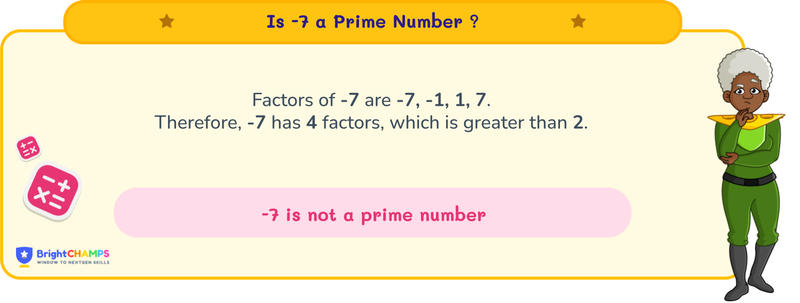Summarize this article:
 211 Learners
211 LearnersLast updated on August 5, 2025
Is -7 a Prime Number?

The numbers that have only two factors, which are 1 and itself, are called prime numbers. Prime numbers are used in encryption, computer algorithms, and barcode generation. In this topic, we will be discussing whether -7 is a prime number or not.

Is -7 a Prime Number?
There are two types of numbers, mostly —
Prime numbers and composite numbers, depending on the number of factors.
A prime number is a natural number greater than 1 that is divisible only by 1 and itself.
For example, 3 is a prime number because it is divisible by 1 and itself.
A composite number is a positive number that is divisible by more than two numbers.
For example, 6 is divisible by 1, 2, 3, and 6, making it a composite number.
Prime numbers follow a few properties like:
- Prime numbers are positive numbers always greater than 1.
- 2 is the only even prime number.
- They have only two factors: 1 and the number itself.
- Any two distinct prime numbers are co-prime numbers because they have only one common factor, which is 1.
- Since -7 is not a positive number greater than 1, it is not a prime number.


Why is -7 Not a Prime Number?
The characteristic of a prime number is that it has only two divisors:
1 and itself, and is greater than 1.
Since -7 is a negative number, it does not meet the criteria for being a prime number.
A few methods are used to distinguish between prime and composite numbers, but the primary criterion is that the number must be a positive integer greater than 1.

Counting Divisors and Negative Numbers
The method of counting divisors to categorize numbers as prime or composite applies only to positive integers.
Negative numbers do not fit the definition of prime numbers.
If there is a total count of only 2 divisors, then the number would be prime.
If the count is more than 2, then the number is composite.
However, since -7 is negative, it does not qualify for this method.
Explore Our Programs



Divisibility Tests and Negative Numbers
Divisibility tests are used to determine whether a number is divisible by another number without leaving a remainder.
However, these tests are only applicable to positive integers when determining primality.
Since -7 is negative, it does not qualify for these tests to determine if it is a prime number.

Prime Number Chart and Negative Numbers
A prime number chart is a tool used to identify prime numbers within a range of positive integers. The Sieve of Eratosthenes, for example, is a common method for generating a list of prime numbers.
Step 1: Write numbers from 1 to 100 in 10 rows and 10 columns.
Step 2: Leave 1 without marking, as it is neither prime nor composite.
Step 3: Mark prime numbers and cross out their multiples.
Since -7 is not a positive integer, it is not included in the prime number chart.

Prime Factorization and Negative Numbers
Prime factorization involves breaking down a positive integer into its prime factors. This process is not applicable to negative numbers, such as -7, as they do not meet the criteria for prime numbers.

Common Mistakes to Avoid When Determining if -7 is a Prime Number
Children might have some misconceptions about prime numbers when they are learning about them. Here are some mistakes that might be made by children.

FAQ on Is -7 a Prime Number?
1.Can Negative Numbers Be Prime Numbers?
2.Why Is -7 Not Considered a Prime Number?
3.What Is the Absolute Value of -7?
4.Can 0 Be a Prime Number?
5.What Is the Definition of a Prime Number?

Important Glossaries for "Is -7 a Prime Number"
- Prime numbers: Positive integers greater than 1 with no divisors other than 1 and itself.
- Composite numbers: Natural numbers greater than 1 that are divisible by more than 2 numbers.
- Divisibility tests: Methods to determine if a number is divisible by another without leaving a remainder.
- Absolute value: The non-negative value of a number without regard to its sign.
- Natural numbers: Positive integers starting from 1 and increasing without end.



Hiralee Lalitkumar Makwana
About the Author
Hiralee Lalitkumar Makwana has almost two years of teaching experience. She is a number ninja as she loves numbers. Her interest in numbers can be seen in the way she cracks math puzzles and hidden patterns.
Fun Fact
: She loves to read number jokes and games.

















